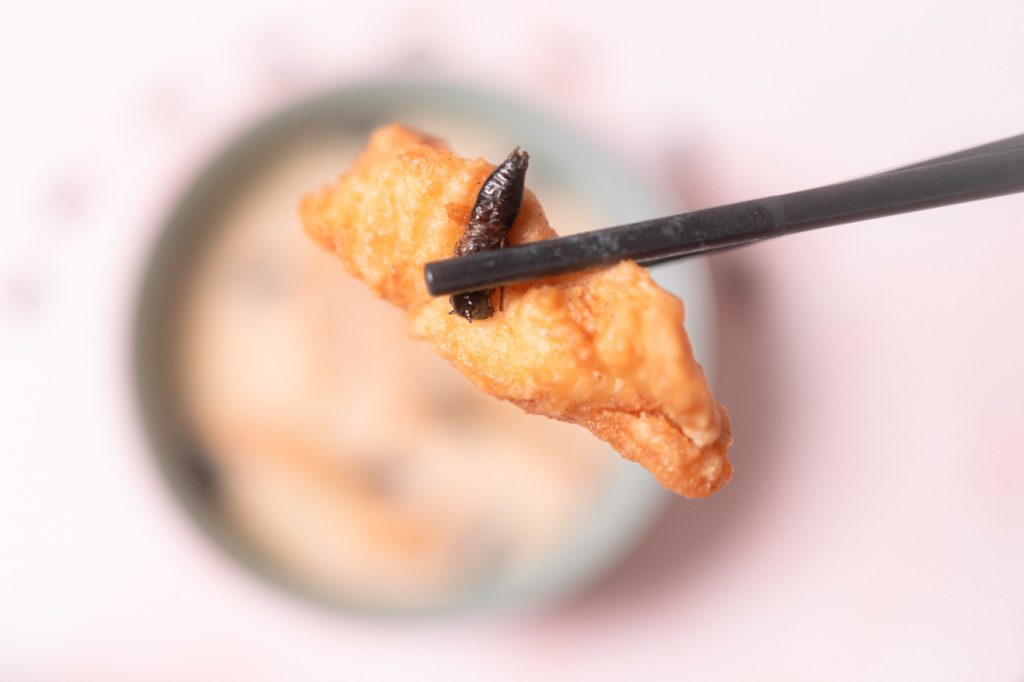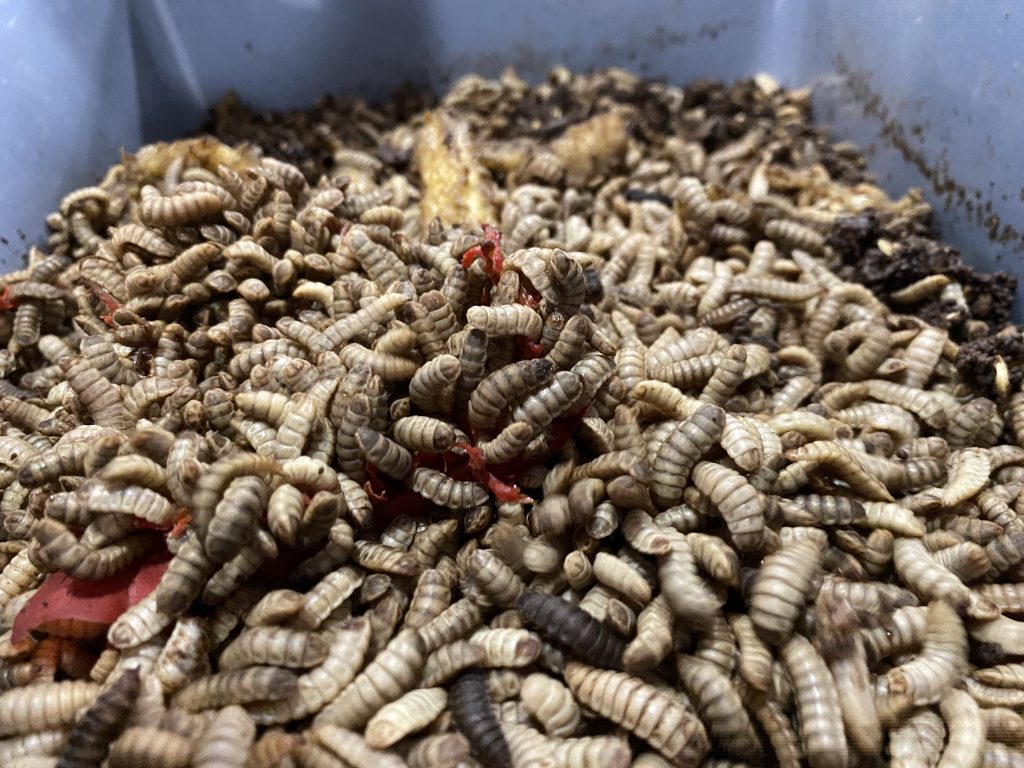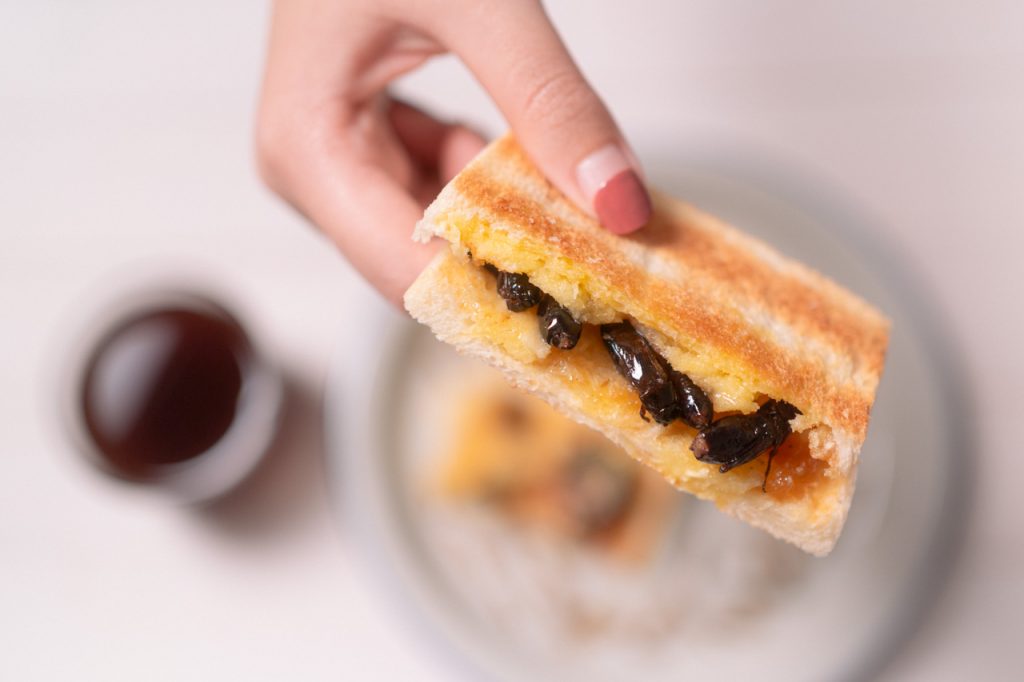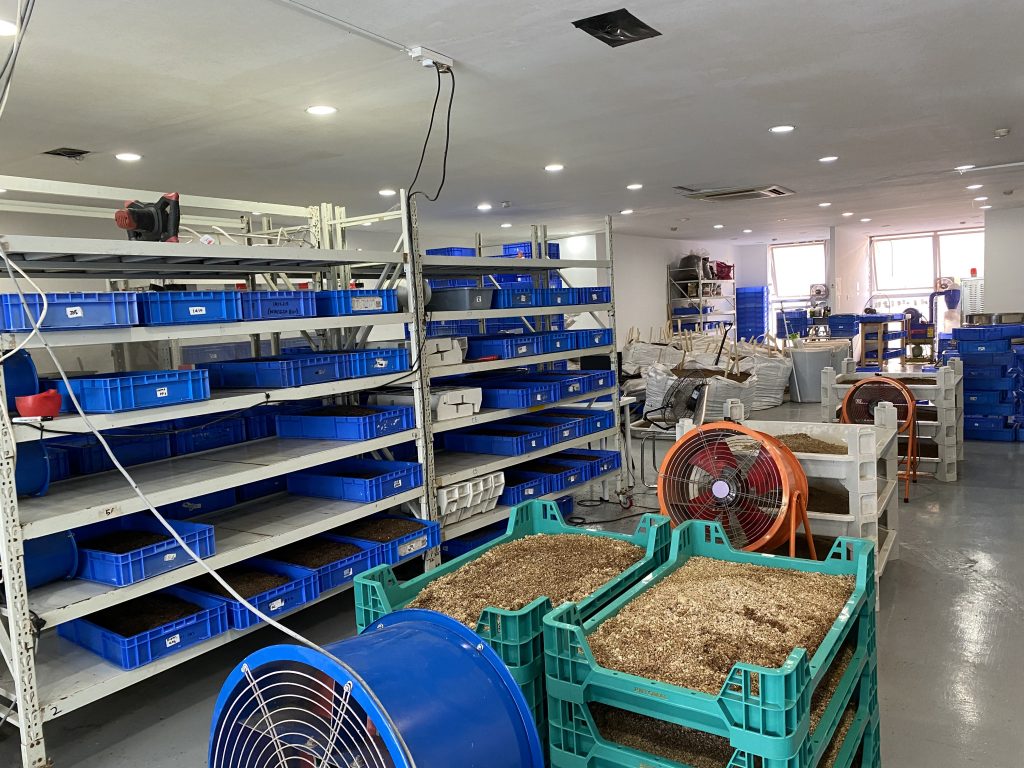All images by Stephanie Lee for RICE Media unless otherwise stated.
Nestled between the pale white strands of silky noodles and nuggets of fried fish, the jet-black fried cricket looks almost comically out of place. A munch in, and we almost gagged; the bits of briny, metallic nuttiness of this bug lend an umami relish that’s rather hard to place.
Still, while an unprecedented fit, the fried cricket’s aromatic, peppery, and crunchy texture—reminiscent of nasi lemak sambal—is slowly growing on us. We like this, maybe. The strangeness of eating bugs gives way to mild acceptance that surprises our colleagues watching us from across the table, brows furrowed, perplexed.
ADVERTISEMENT
We gamely chomped down on the remaining scraps of crickets and fish slices. The room is silent save for crackle-crunch-crackle-crunch-crackle. Soon, the table is only left with empty plastic containers. We slouch backwards on our chairs, sighing in food coma satisfaction. We check our teeth for stray bug legs and wings.
Day one of eating crickets with local dishes is off to a good start.

The Build-Up to Day 1
“We don’t sell edible insects here. It’s illegal in Singapore. Maybe you could try our pork crackers instead,” the auntie at the snack store sharply quipped. Pork crackers for edible crickets, however, wasn’t the exchange we were looking for.
For the next hour or so, we trawled through the dimly lit corridors of Golden Mile Complex in search of a store that might have artfully-hidden packets of edible insects away from the reach of local health and safety regulations.
Initially an off-the-cuff suggestion in our weekly pitch meetings, the 7-day insect diet challenge took on a life of its own. Along the way, it piqued the curiosity of our editors and raised the eyebrows of colleagues, concerned that we were bullied into eating crickets for content.
Let us assure you that—*reaches for the signed waiver*—we interns do this freely, willingly, and have been duly informed of potential risks.
The search for cricket hors d’oeuvres becomes more arduous given the fact that the Singapore Food Agency (SFA) maintains that selling insects for human consumption is illegal here.
Indeed, Kai-Ning Chua, Chief Marketing Director at Insectta—Singapore’s first urban insect farm start-up—explains why selling edible crickets has yet to be legalised here, despite being common everywhere else in Southeast Asia.
“If there is no demand for edible insects, policymakers do not need to write them into law. However, if we change our attitudes towards insects, the legal side will be faster. It’s a chicken-and-egg thing.”
Crucially, edible insects, recognised as a form of alternative protein by SFA, have yet to meet the slew of local safety assessments meant to prevent food safety risks.
Realising that we weren’t about to stumble on insect-bug-cricket anything at Golden Mile, we headed home, ready to face the barrage of “Did you even try? Are you sure?” enquiries from our editors that we were sure were coming our way.
ADVERTISEMENT
And then, as if on cue, Toke, our colleague who had just returned from Thailand and heard of our assignment (and desperation), informed us that he was ready to part with his bag of edible crickets—something he bought out of sheer impulsiveness. Deus ex machina manifested.
Nasi Cricket, Anyone?
Crickets with kaya toast. Mealworms with laksa. Fried ant rice. Quintessentially Singaporean recipes currently unheard of, but brimming with potential feasibility for delectability.
Like chicken, we wondered out loud if crickets could genuinely be enjoyed locally as different meals throughout the day; breakfast, lunch, dinner. If that’s too drastic a suggestion, could it be at least incorporated into our repertoire of food options?
That’s when we thought to insectify accessible and highly recognisable Singaporean dishes—kaya toast, mala bowls, chicken rice. We imagined a future with insects in our long-term diet, where our favourite mala stall would sell chilli crickets at S$2.99/100 grams.
Some of our colleagues suggested we conceal these visually off-putting critters beneath our food. “It may be easier for you to stomach it since you can’t see it,” they advised.
Out of sight, out of mind seems like a perfectly reasonable mantra. A little cowardly, but given a general aversion to all bugs, it feels like an approach that would make these seven days more… well, palatable.

Most Foods Are Acquired Tastes Anyway
At the start of the challenge, buggy meals were relatively big occasions. Inquisitive colleagues would ask what we were going to eat. Near lunchtime, armed with the mission to change minds, we sprung freshly prepared crickets on unsuspecting colleagues as they hunch over their desks, ready to tuck into yet another plate of typical everyday lunch fare. Pfft. Normies, the lot of them.
Still, we understand anyone’s initial repulsiveness when faced with a full bowl of fried crickets. Crickets, fried to a crisp, sport a shade of brown reminiscent of the common street cockroach that we have long associated with dirtiness, unhygienic habits, poor life decisions, and for some, a real fear of them flying straight at you.
It is this unfortunate association that fortifies the mental barriers that held many of our colleagues and us back from digging in.
“The crickets look dirty, so they must be dirty,” we convince ourselves.
However, that could not be further from the truth. Farmed insects undergo a strict diet regimen and are kept in controlled, sterile environments.
“Farmed insects, like black soldier flies which we incorporate into animal feed and plant fertiliser, are not like the flies you see flying around at home,” explains Sean Tan, a former civil servant who is now CEO of Insect Feed Technologies. “I feed them carbs, proteins, and amino acids. In that sense, their diets are clean and carefully controlled.”
Like many other farmed animals, Black soldier flies need the proper nutrients to grow, Sean believes. The production process of these farmed flies is so sterile and controlled that hypothetically, any plucky visitor at his black soldier fly farms could eat larvae fresh from the oven. Yum.

Exotic to Mundane. The Cricket Becomes Boring.
Soon, we developed a steady routine. By day 3, the interest and curiosity around eating insects waned. Bowls of fried crickets we left lying around in the office became a common sight. The mental barriers people had about eating insects got more and more insignificant as we ate the crickets.
Kai summarised our initial apprehensions when it came to insect-eating. “The stigma, or phobia, towards eating insects is purely social. Our generation has been conditioned since young not to see insects as mainstream snacks. We might be able to undo this mindset, but the stereotype towards insects remains.”
In some cases, part of the stereotype against insect-eating comes from who we think consumes insects. In our modern, first-world, cosmopolitan city-state, do we feel above eating insects simply because beef, fish, chicken, and pork will always be available?
Insects are for those without options, we might decry.
Perhaps such stigma could be overcome by letting people try eating these critters in the first place, or at least by incorporating insects into their overall diets. Still, the most important step is getting people to try. Eliminating negative stereotypes can wait.

Singapore’s Thriving Insect Industry
A 2017 NBC article revealed that crickets are 12 times more environmentally efficient than cattle in converting feed to produce meat—at least four times more efficient than pigs, and twice as efficient than chicken.
Sean concurs with this assessment. “Per kilogram of protein, crickets take up 4 square metres of land, compared to chickens, which take up about 51 square metres of land. Being space-efficient is important in land-scarce Singapore.”
For other insects like the black soldier fly, Sean notes that minimal land and very little water are needed per kilogram of protein, and there is less carbon dioxide and energy output compared to chicken or cattle farming.
“Compared to other forms of protein, crickets are also considered clean protein—protein without fat,” Sean shares. Furthermore, a 2020 Healthline review showed that the human body digests cricket-based protein better than plant-based protein like rice or corn.

Eating Insects — Green or Red Light?
Our bodies seem to agree with Healthline. Seven days breezed past with nary a stomach ache or any bodily discomfort.
We also noticed that pre-workout drinks like cricket-based protein shakes energise our body just as well as any regular protein shake.
Moreover, like any other ingredient, crickets work in some dishes and not so much in others. We found that the mala cuisine pairs exceptionally well with crickets, with the aromatic, peppery spice complementing its crisp crunch.
When jammed between slices of our kaya and butter toast, the nuttiness of the fried crickets enhances the salty-sweet elements from the butter and kaya spread. The saltiness from the cold slab of butter coats the crunchy bugs—as if we were savouring cream crackers with kaya spread and butter.
Fish soup with crickets, however, makes very little savoury sense. Crickets, originally fried to a crisp, grow soft after absorbing the broth they float in.
Still, the chewy crickets with a sensory overload of that metallic aftertaste proved too much to handle—an assault on the senses that might need a little more than seven days to get used to.
Thank God for the chilli padi then; a surprising saviour in our fried fish-cricket soup, dialling back the insect’s metallic aftertaste to a considerable degree.
When eaten with cupcakes, opinions were equally divided. The crickets, which have a nutty flavour when fried, combine well with the sweetness of the frosting. Plus, just look how adorable they are jutting out of the whipped cream.

More Crickets to Come: The Road Ahead
While edible insects have yet to be normalised in Singapore, they remain the conquest of brave Singaporean tourists on vacation in Thailand or Vietnam in search of their “exotic” vacation story for Instagram.
The reality, however, is much more mundane. Singapore is one of few Southeast Asian countries which have yet to legalise the sale of insects for human consumption. Ultimately, insects are a source of food in most parts of the region, as much as they are considered creepy crawlies or pests.
Sean echoes this sentiment and astutely points out that edible insects are conventional elsewhere. “In other places, most insects have been eaten for more than 20 years. It’s prevalent in South America and Southeast Asian countries.”
Indeed, if insect-eating were given a chance to be normalised, we reckon it wouldn’t be any different from how we now enjoy durians or smelly tofu. We imagine that there will be equal parts die-hard fans who swear by their nutritional benefits as well as disgusted detractors, barely able to stomach even the thought of putting a critter near their lips.
Like any contentious food, they would be equally loved and loathed. And that’s better than the current state of unfamiliarity with eating insects.
“An increasing number of preschoolers and kids come up to us when touring our farms and tell us that they are not scared of insects,” Kai revealed, alluding to how some of our fears behind edible insects are purely social constructs.
“The future consumers of insects will be the younger generations.”
In a time of extreme climate change and fears of food scarcity, Kai’s prediction could very well be prophetic. Along with the younger generations, we might not be far from our first bite of mala crickets and fish-cricket soup. We’re all for it. Dig in.






